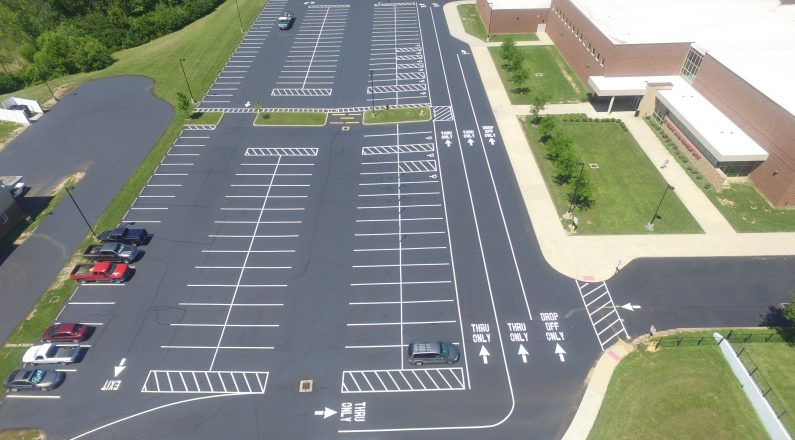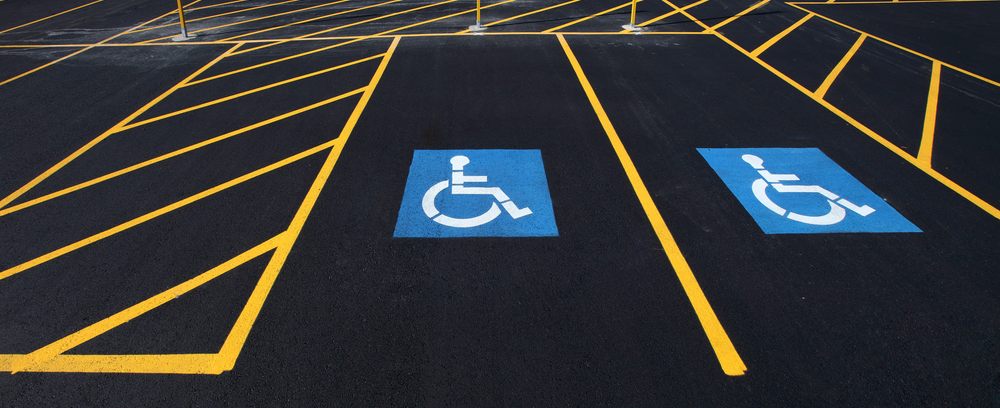Recognizing the Relevance of Roadway Paint in Urban Framework Advancement
The function of road painting in urban infrastructure advancement extends beyond mere aesthetics, serving as a foundational aspect in improving safety and security and enhancing traffic flow (Parking lot line painting). Effective roadway markings not just offer critical guidance for both chauffeurs and pedestrians yet likewise add to the total functionality of metropolitan areas.
Security Enhancements Through Roadway Markings
Frequently ignored in metropolitan facilities advancement, road markings play a vital duty in enhancing security for both chauffeurs and pedestrians. These markings work as vital visual signs that assist lorry activity and develop order on roadways. Appropriately created and preserved roadway markings communicate important information, such as lane borders, pedestrian crossings, and stop lines, properly decreasing the probability of mishaps.
The visibility and quality of road markings are paramount, particularly in unfavorable climate condition. High-contrast materials and reflective paints aid ensure that markings stay discernible at night and throughout rainy problems, thus improving safety and security end results. The application of standard symbols, such as arrows and pedestrian symbols, promotes much better understanding amongst road customers, advertising compliance with website traffic policies.
In addition to their practical aspects, roadway markings contribute substantially to the overall aesthetic of urban settings. Well-executed road paint boosts the visual appeal of streetscapes while all at once strengthening the importance of road safety and security. As cities remain to grow and progress, focusing on the top quality and maintenance of road markings is vital in promoting a effective and risk-free transport system for all customers.
Influence On Traffic Circulation
Maximizing web traffic circulation is dramatically affected by the tactical implementation of roadway markings. Effectively developed and preserved roadway markings provide necessary assistance for vehicle drivers, promoting smoother navigation through various web traffic scenarios. By plainly defining lanes, suggesting turning points, and marking intersections, roadway markings help in reducing confusion and protect against mishaps, eventually boosting total traffic effectiveness.
In addition, road markings play a crucial role in managing vehicle rates. For circumstances, the usage of lane reduction markings and speed up limitation indications can affect motorist habits, motivating adherence to secure driving methods. This, subsequently, reduces blockage and promotes a much more fluid motion of lorries.
In addition, well-placed road markings can boost the effectiveness of web traffic signals and indications. By guaranteeing that these components are visually enhanced through ideal sidewalk markings, drivers get constant and systematic info, permitting more enlightened decision-making.
In metropolitan environments, where website traffic density is high, the combination of innovative road paint strategies, such as reflective and thermoplastic products, can additionally improve presence under different climate condition. In summary, efficient roadway markings are essential for optimizing web traffic flow, adding to safer and a lot more effective urban transport systems.
Supporting Pedestrian Navigating
Reliable road markings are crucial for sustaining pedestrian navigation, particularly in urban locations where foot website traffic is substantial - Road painting near me. Clear, distinct crosswalks, directional arrows, and pedestrian Related Site signs improve presence and guide pedestrians safely throughout roads. These markings educate pedestrians of their right-of-way, reducing the probability of accidents and boosting general safety
Moreover, effective road painting can define various zones within the urban setting, such as dividing pedestrian courses from automobile lanes. This delineation promotes a safer strolling experience, encouraging raised foot website traffic and advertising metropolitan vitality. Markings that mark pedestrian-only areas or shared spaces even more boost navigation by making clear where pedestrians can safely pass through without disturbance from vehicles.

View Line painting Abbotsford in a full screen map
Aesthetic Contributions to Urban Style
The aesthetic payments of road paint considerably boost city layout, changing average roads into visually involving rooms. Attentively made roadway markings and vibrant colors create an this page aesthetic narrative that can mirror the identification of an area. Imaginative crosswalks, as an example, not just serve their functional purpose but likewise work as public art installments, motivating community communication and pride.
Moreover, the critical use of color can affect understandings of security and access. Brightly repainted bike lanes and pedestrian zones can define areas, making them much more appealing and Visit Website urging their usage. This, subsequently, promotes a feeling of neighborhood by advertising active transportation settings, such as walking and biking.
Furthermore, roadway painting plays a crucial duty in urban revitalization efforts. By incorporating creative components into the road style, cities can develop a cohesive aesthetic that improves the total urban landscape, drawing in site visitors and citizens alike. Such improvements can cause raised financial activity, as visually pleasing environments are more likely to draw individuals in. Ultimately, the aesthetic contributions of roadway paint are important for the creation of vivid, habitable city spaces that reverberate with the neighborhood's personality and aspirations.
Ecological Factors To Consider in Roadway Paint

To reduce these problems, the adoption of environment-friendly choices is important. Water-based paints and those made from lasting products help lower VOC emissions and improve general ecological impact. Additionally, reflective and polycarbonate markings can enhance visibility while minimizing the need for frequent repainting, therefore reducing material consumption in time.
Moreover, road paint can be incorporated with urban green initiatives, such as utilizing permeable materials that permit rainwater to infiltrate, consequently reducing runoff and promoting groundwater recharge. In summary, while road painting is essential for urban performance, it is necessary that environmental considerations guide product choice and application approaches to make certain sustainable urban growth.
Verdict
In final thought, roadway paint plays a critical duty in metropolitan infrastructure growth by improving security, maximizing traffic circulation, and sustaining pedestrian navigation. Furthermore, focus to ecological considerations in road painting contributes to sustainable city advancement.
